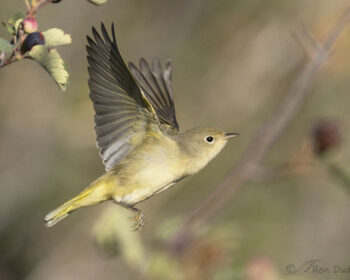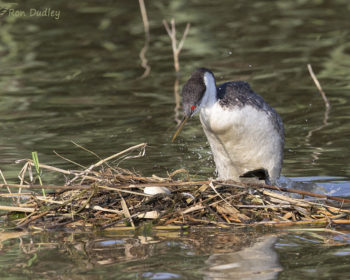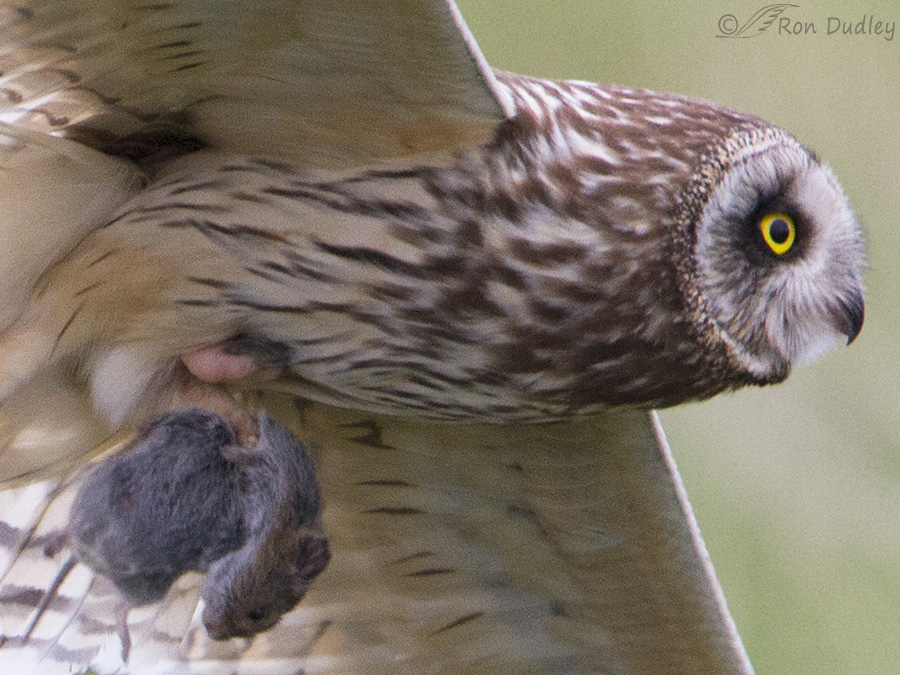Tag: brood patch
Western Grebe Still Incubating Eggs Yesterday Morning
Brood Patch Of A Female Short-eared Owl In Flight
Brood Patch In A Female Short-eared Owl
One of the primary functions of feathers is insulation and they’re very good at preventing heat loss. But this efficiency presents a problem – how to keep the egg(s) sufficiently warm during incubation, since feathers act as a barrier to heat transfer from parent to eggs. Typical bird body temperature is about 104 degrees F. and the ideal incubation temperature for their eggs is very close to normal human body temperature – 98.6 degrees F. That dilemma has been solved by most bird species through the evolution of the “brood patch” – an area of belly skin that loses its feathers near the end of the egg-laying period. As the feathers are lost, supplementary blood vessels engorge the skin of the “patch” so that hot blood is brought to the surface. Amazingly, the parent can even shut down blood flow to this region when that bird is off the nest. When the incubating parent returns to the eggs for incubation, he/she typically goes through settling movements that bring the brood patch into gentle contact with the eggs. The patch may be large or small, depending on a variety of factors including how many eggs are incubated. Some species have a single patch in the middle of the belly, others may have one each side or even three. Typically the patch is difficult to observe in wild birds, particularly in flight but I have several images of a female Short-eared Owl where it is visible. This female had two chicks that she was trying to keep warm during a typically cold Montana spring. The male…
The Short-eared Owls of Red Rock Lakes National Wildlife Refuge
Male Short-eared Owl with a vole for the family Red Rock Lakes NWR is simply a wonderful spot on this ol’ earth. Located in SW Montana about halfway between Yellowstone National Park on the East and Interstate 15 on the west, it lies in a beautiful high elevation valley and the setting is stunning. It’s not for the faint of heart though as the weather holds many potentially nasty surprises and the access to the refuge is primitive at best. But that’s one of the things I love about Red Rock. In late June we had the place mostly to ourselves, which is ideal for me. Coyotes howling, other mammals in abundance, birds plentiful, wildflowers galore, spectacular mountain scenery, amazing sunrises and sunsets, weather surprises, bad roads to limit visitation, isolation and especially those incredible Short-eared Owls. I love this place! Female at the nest with one of two youngsters On our second day there we found a pair of nesting Short-eared Owls with two youngsters. The nest was at the base of a sagebrush within a few feet of a road. I have a (very unscientific) theory as to why these birds would make their nest so close to a road with regular traffic. Coyotes are very common on the refuge – we heard them howling often and would see them but they were seldom close to any road. They seem to avoid roads whenever possible. A nest on the ground would be very vulnerable to coyote predation. So I wonder if the choice to build…
Western Grebe Still Incubating Eggs Yesterday Morning
Brood Patch Of A Female Short-eared Owl In Flight
Brood Patch In A Female Short-eared Owl
One of the primary functions of feathers is insulation and they’re very good at preventing heat loss. But this efficiency presents a problem – how to keep the egg(s) sufficiently warm during incubation, since feathers act as a barrier to heat transfer from parent to eggs. Typical bird body temperature is about 104 degrees F. and the ideal incubation temperature for their eggs is very close to normal human body temperature – 98.6 degrees F. That dilemma has been solved by most bird species through the evolution of the “brood patch” – an area of belly skin that loses its feathers near the end of the egg-laying period. As the feathers are lost, supplementary blood vessels engorge the skin of the “patch” so that hot blood is brought to the surface. Amazingly, the parent can even shut down blood flow to this region when that bird is off the nest. When the incubating parent returns to the eggs for incubation, he/she typically goes through settling movements that bring the brood patch into gentle contact with the eggs. The patch may be large or small, depending on a variety of factors including how many eggs are incubated. Some species have a single patch in the middle of the belly, others may have one each side or even three. Typically the patch is difficult to observe in wild birds, particularly in flight but I have several images of a female Short-eared Owl where it is visible. This female had two chicks that she was trying to keep warm during a typically cold Montana spring. The male…
The Short-eared Owls of Red Rock Lakes National Wildlife Refuge
Male Short-eared Owl with a vole for the family Red Rock Lakes NWR is simply a wonderful spot on this ol’ earth. Located in SW Montana about halfway between Yellowstone National Park on the East and Interstate 15 on the west, it lies in a beautiful high elevation valley and the setting is stunning. It’s not for the faint of heart though as the weather holds many potentially nasty surprises and the access to the refuge is primitive at best. But that’s one of the things I love about Red Rock. In late June we had the place mostly to ourselves, which is ideal for me. Coyotes howling, other mammals in abundance, birds plentiful, wildflowers galore, spectacular mountain scenery, amazing sunrises and sunsets, weather surprises, bad roads to limit visitation, isolation and especially those incredible Short-eared Owls. I love this place! Female at the nest with one of two youngsters On our second day there we found a pair of nesting Short-eared Owls with two youngsters. The nest was at the base of a sagebrush within a few feet of a road. I have a (very unscientific) theory as to why these birds would make their nest so close to a road with regular traffic. Coyotes are very common on the refuge – we heard them howling often and would see them but they were seldom close to any road. They seem to avoid roads whenever possible. A nest on the ground would be very vulnerable to coyote predation. So I wonder if the choice to build…




